Graft-Free Queen Rearing by Morris Ostrofsky
This resource was created by Morris Ostrofsky. I’ve included it here as a resource for people who want to explore queen rearing. Resources like this one, and the encouragement of “friend-tors” like Sam Comfort helped me take the plunge into rearing my own queens. Raising queens helped me develop a deeper understanding of the hive, and helped me shape my own beekeeping practice. Like anything on our learning edge, learning how to raise queens may make you question your skills, knowledge and understanding, but it will ultimately help you develop a deeper understanding of the hive’s rhythms.
The Graft-Free Queen Rearing document is also available for download as a PDF.

Many beekeepers reach a point in their beekeeping experience where they are comfortable with the basics and are seeking a new challenge. In an environment in which beekeepers have to deal with varroa and diseases and are dissatisfied with commercial queens there are reasons to raise your own queens. However, for many beekeepers the idea of grafting and producing their own queens is intimidating. The purpose of this paper is to offer four simple methods of queen rearing that do not require grafting. I will explain how a few high quality queens can be raised without special equipment or tools by a beekeeper with just a few years of beekeeping experience.
To quote Dr. C.L. Farrar, USDA Honey Bee Research Lab Leader, Madison, Wisconsin, “Below average queens living in a great environment will out perform a great queen living in a poor environment every time.” It is possible to create a great queen if they are well fed and raised in a bountiful environment.
In the last few years a common complaint I hear is the poor quality of queens that are available e.g., poorly mated. Another frequent complaint is the lack of acceptance. Not only is the acceptance track record poor but even when the queens are accepted, too many are superceded. The queens you purchased from half way across the country often do not perform as advertised in your own back yard. Locally produced queens are well adapted to your environment. To quote Kim Fottum, editor of Bee Culture magazine, “As Mark Twain might have said, ‘The difference between queens you buy and queens you raise yourself is almost always the difference between light and lightening.’”
Before describing various methods of graft free queen rearing, I would like to discuss some of the benefits of raising your own queens. One is genetics. Many beekeepers are wisely looking to genetics as a means of a long term solution to solving the problems associated with the exotic pests and diseases. When you raise your own queens, you can select for desirable traits e.g. disease resistance, hygienic behavior. Usually everyone has a favorite hive or knows a fellow beekeeper that has a hive with desirable traits. The queens in these hives are the cornerstone of improving an apiary.
Genetics is an excellent foundation. You can build on this foundation by controlling the conditions in which the queens are raised by selecting the genetic stock, using chemical free comb and ensuring that they are well fed as they develop.
Finally we all accept the fact the young queens are more productive and less likely to swarm. Having extra queens readily available means being prepared for emergencies; e.g. accidental death of the queen. Because of these reasons, many beekeepers want to take charge of the situation and raise their own queens. Most erroneously assume that grafting is the only way to accomplish this. However, this is not the case. There are multiple methods of graft-free queen rearing. Four methods are presented: Swarm cell, Nucleus, Miller and Hopkins. The reader can choose the method that best suits his/her comfort level and the number of queens desired.
Regardless of the method selected there are certain considerations that are common to all. Time of year is one. Spring and summer are the ideal times to raise queens. Food is available, the temperatures are correct for virgins to mate, and the bees’ natural inclination to propagate by producing new queens and swarming takes place. Fall is not the best time to raise new queens. There is less food available to produce a well fed queen. There are fewer nurse bees. Nor is there time for new queens to set up a hive with enough winter stores. But more importantly there are fewer drones available for mating.
Another consideration before venturing into queen rearing is preparation. Populations need to be strong; a decision needs to be made as to which will be the queen breeder (queen mother) and drone mother hives, and what additional equipment is needed. An adequate supply of protein supplements and feeding stimulants should also be on hand. A schedule should be made especially if the Hopkins or Miller methods are used.
All honey bees are not the same. As Charles Darwin correctly pointed out, “Within any population there are variations.” Case in point, look at your siblings; unless you have an identical twin, everyone is different. When selecting which hive(s) is to be used for your source of your breeder queens (AKA queen mother, queen mother hive), consider traits that are important to you. This is one of the areas where you have the most control of the quality of the new queens. There are a number of desirable traits you may wish to select for: gentleness, honey production, early build up, hygienic behavior, disease resistance, and good wintering ability. Your experience with your hive(s) will dictate which colony (colonies) you select as the queen mother hive.
Another decision you have to make is the number of queens you would like to produce. The most limiting factor in any queen rearing operation is the number of available mating boxes. This is an appropriate time to define mating box/nuc for the purpose of this paper. While mating boxes vary in size from as small as 2 full depth frames to 5 full depth frames, I use a standard 5 frame full depth nuc box with a follower board. Using this configuration means no special equipment is needed whether the nuc is used as a nuc or a mating box.
Graft free queen rearing requires between one and four hives depending on the method used. Each will be discussed separately with the corresponding method. At least one mating box/nuc is needed for every queen produced. Early on it will be necessary to decide the number of desired queens and prepare the appropriate number of mating box/nucs.
Overcrowding and better fed queen cells go hand in hand. Ideally the hives you raise queen cells in (cell builder hives) should be overcrowded with lots of young nurse bees. In fact the colony must be on the verge of swarming. To quote Sue Cobey (researcher at UC Davis), “Overcrowding is the secret of success.” The objective is numerous and well fed larvae. Feeding is the way to accomplish this objective. The quantity and quality of feeding greatly influences the quality of queens. This is one important way you can produce higher quality queens than those mass produced. “This is an important concept and must not be overlooked.” (Sue Cobey at OSBA 2012 conference) According to Sue Cobey well fed developing queens produce more eggs. Feeding the bees a pollen supplement is added insurance that the growing queens will have an adequate amount of protein. Use your favorite pollen supplement. Since you want a population that is booming, start feeding the potential cell builder hives about 2 months before you start raising queen cells.
A large drone population is needed in the cell builder hive(s) in addition to a large worker population. Drones do much more than serve as fodder for bee humor. They are an important, yet overlooked, part of the mating equation. It takes about 12 to 15 drones to mate with a virgin queen. Think of them as flying gametes.
To build and maintain the population of drone mother hives start feeding them a 1:1 sugar syrup solution with a feeding stimulant at least one month before starting to raise queen cells. Feeding needs to continue until the new queen has been mated. If the bees perceive a slow down in nectar flow; e.g. the feeding, they will stop drone production and also start removing developing drones from the hive. Drone production needs to continue right up to the time the queen is mated.
An additional method to increase the number of drones is the use of green plastic drone comb frames. The embossed cells are drone-sized; larger than the worker brood size. When the queen feels the larger sized cells, she lays an unfertilized egg which becomes a drone. When inserting these frames place them on the edge of the brood area between the pollen frame and the outer most brood frame at approximately the three or eight positions.
In most cases, two drone producing hives will be necessary for every hive that is producing queen cells. If there are other hives within a quarter to a half mile of your apiary, extra drone hives are not necessary. The exception to this is if you’re trying to improve genetics. In this case the best hives for producing drones (drone mothers), will be your own. The drone mother hives should be placed a half mile away from the mating boxes/nucs. The reason for moving your own drone mother hives away from your apiary is to avoid inbreeding between virgin queens and their brothers. Additionally you increase the likelihood of matings with selected drone stock. This is because the drones normally form their congregation areas closer to “home” than a half mile. The virgin queens typically fly further away from the home apiary and have a better chance to mate with the desired drones.
The Queen Development chart that follows illustrates the biological sequence of a queen’s development and mating and explains the “why” and “when” specific manipulations are performed. For example if you were to wait until day 17 to separate the queen cells in a cell builder, you would end up with a single queen. This is because on day 16 the first queen to emerge would dispatch all of her sisters. The beekeeper must be aware of the queen’s development sequence to successfully raise queens. The chart helps to visualize the process and is referenced as the methods are described.
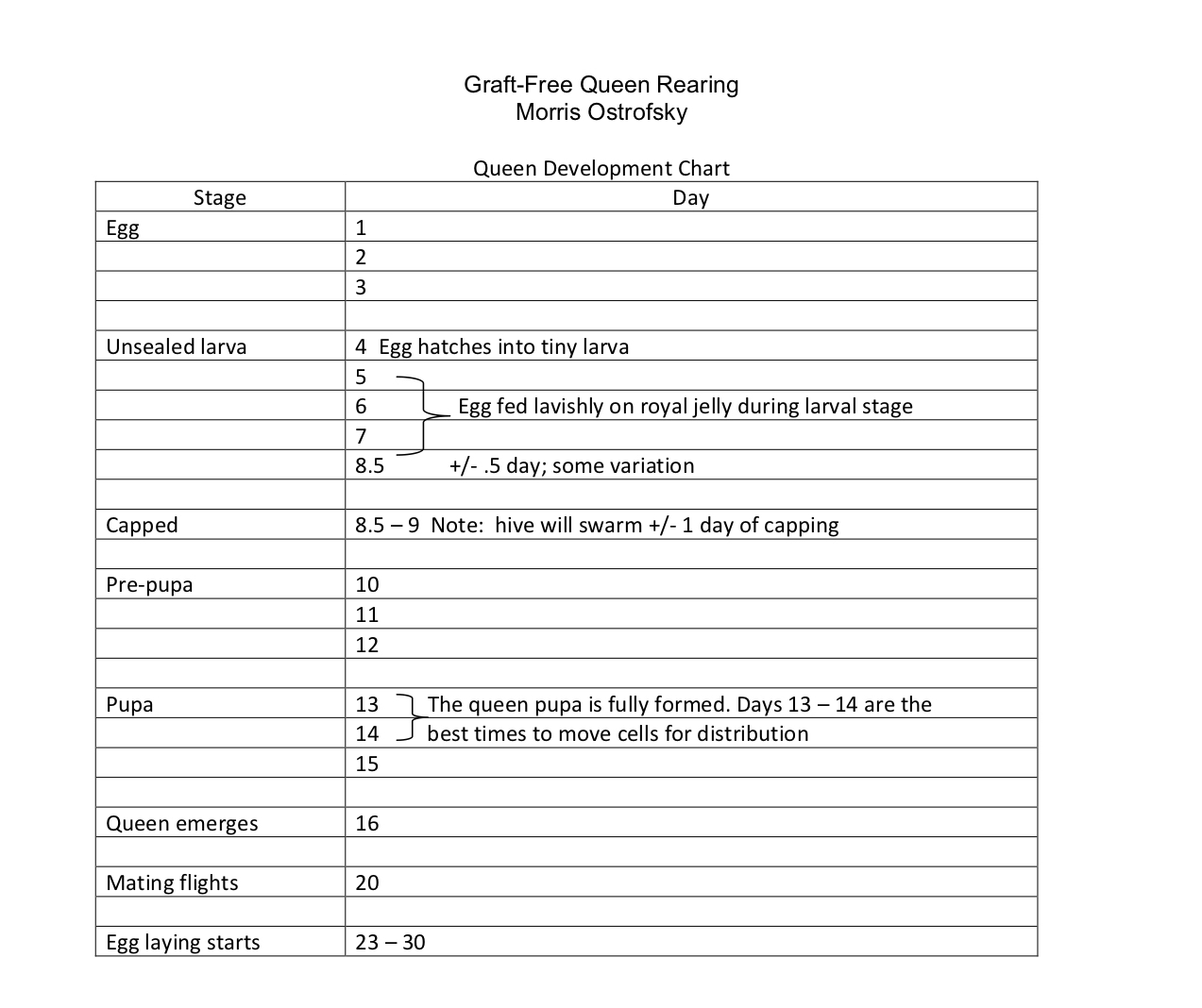
Before any queen rearing project can be started, production activities have to be coordinated with seasonal and personal calendars. Seasonal conditions set the pace for raising queens. When the average temperature reaches 69 degrees F, the queen is able to go on her mating flight(s). For example in the southern Willamette Valley, the average temperature is 70 degrees F on June 1st. This is one degree warmer than the absolute minimum required for a virgin queen to mate. I use June 1st as the focal point for activities I schedule before and after this date. The timing of the mating flight(s) is critical and thus set the pace for the rest of the calendar. Because beekeeping is local, the date the temperature reaches 69 degrees F will vary as will specific calendars.
While most scheduling is flexible, some manipulations are less so. For example once 24-36 hour larvae are placed into the cell builder, the scheduling becomes more rigid. This is the point to make sure your personal schedule does not conflict with queen rearing activities. The Miller method, described later, will include an example of how useful a calendar is in organizing the sequence of steps for this or any other method.
Now that preparation common to all methods has been described, it is time to look at the specifics of the four methods of non-graft queen rearing. While raising queens is the objective, each uses a different approach. Although several of the steps are common to all, each will be presented as a stand alone process. Review each method and decide which is compatible with your goals and confidence level.
Swarm cell method: Ten to 15 quality queens can be produced from swarm cells. While a swarm cell situation can be created by stimulating a hive, the focus here is the situation where you did not plan for swarm (queen) cells but discover them during a hive inspection. You see that the workers have already built numerous, capped queen cells.
The Queen Development chart shows that the capped cells you are seeing are at least 8.5 days +/- .5 day old. How do we know this? This is because queen cells are capped over at about 8.5 days +/- .5 day. The presence of capped queen cells indicates that the old queen has already left with a swarm which usually leaves within a day before or after capping. Reduced population is also a clue. This can be confirmed by observing a reduced worker population in the hive and the fact that no eggs or very young brood are present.
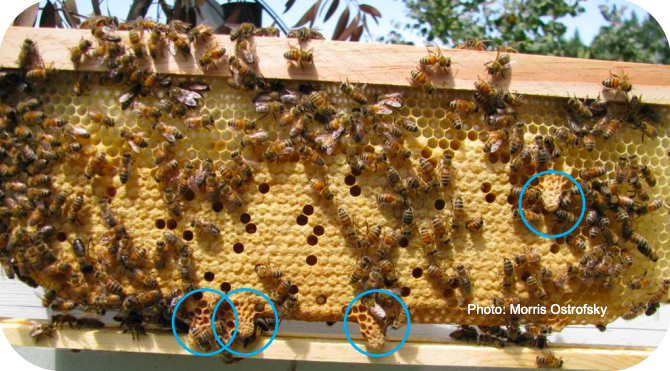
Although you did not actively work to produce these cells, many of the parameters for producing quality queens are present in this situation. The swarm cells have been produced in a hive that has survived winter, is prospering, and has a population that is healthy and vigorous enough to outgrow their home. These cells are well fed and made in a queen right hive.
Now that you have swarm cells, you have to decide how you want to proceed. You can re-queen the hive, make divisions (nucs) or produce mated queens in mating boxes. If you decide that you have enough hives and simply want to re-queen the mother hive, simply cut out all but one or two queen cells. Let the bees raise their own new queen.
To increase hive numbers you will use the queen cells to set up mating boxes/nucs. The goal is two queen cells per division. Sometimes a queen cell is empty and using two cells increases the likelihood of success.
The number of divisions or mating boxes will be largely dependent on the strength of the hive and the number of available queen cells. In an ideal situation you will find a few brood frames with a couple queen cells each. The frames could be used as is. But more often the queen cells are clustered with many on a single frame. In this case, the cells will have to be removed and distributed to maintain two queen cells per mating box/nuc.
Step 1: Decide how many queens/nucs you can produce after evaluating your resources; e.g. amount of brood, workers to care for the brood, queen cells and availability of mating boxes/nucs.
Step 2: Set up the nucleus hive or mating box using the original hive as the source of materials. If the resources of the mother (original) hive do not support the number of mating boxes/ nucs you choose to make, you can supplement using brood and workers from other hives.
Nucleus configuration:
- Three brood frames of capped brood with some cells that are emerging
- If the queen cells are located singly or in doubles on brood frames, simply include the brood frame with the queen cell(s)
- If the queen cells have been removed from mother hive frames, provide a space in the nucleus frames that are to receive the queen cells by cutting out a small portion of comb. The queen cells can then be placed in the space and fixed in place with a couple of tooth picks
- one frame of mostly pollen
- one frame of mostly honey
- enough workers to cover the brood and queen cells
Mating box configuration:
- one frame of mostly honey and pollen
- one brood frame with emerging brood
- 2 queen cells
- enough workers to cover the brood and queen cells
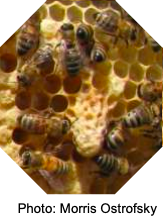
Step 3: Leave one or two capped cells and at least a couple brood frames behind in the original hive. One of these remaining queen cells will become the new queen in the mother hive.
Step 4: Cut out well mottled queen cell(s) from the original hive. These cells should look roughly like the shell of a Virginia peanut. Remove some of the surrounding comb along with the queen cell to avoid damage the developing queen. The extra comb also provides a means to attach the cell to another frame. (See next photo) These cells will be used to set up the queenless mating boxes/nucs.
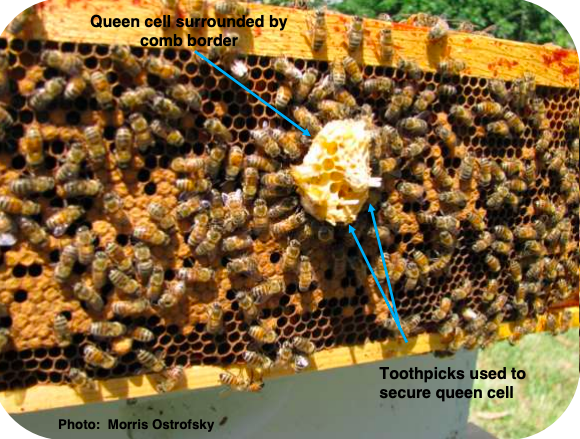
This photo illustrates placement of a queen cell in either a nuc or a mating box. Toothpicks were used to secure the queen cell onto the frame. Note the border of comb that surrounds the queen cell.
Step 5: If the nuc or mating box remains in the same yard as the mother hive, add an equal amount of bees to the nuc/mating box to compensate for the fact that the field bees will drift back to the original hive. Be sure the queen is not included when adding the extra bees.
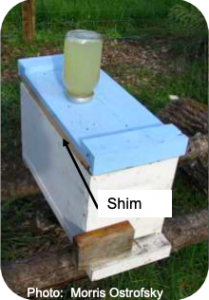
Step 6: Feed and reduce entrance. Before closing up the nuc, add a shim to create some space above the top bars and then add a protein patty. The nuc’s cover should have a 2 to 3 inch circular hole cut into the center. Place an inverted mason jar with 1:1 sugar syrup over the hole. The holes in the Mason jar lid should be 1/16 inch in diameter. Include a feed stimulant, such as Honey Bee Healthy, in the syrup. Cover the feeder with an empty box or bucket to protect the syrup from sunlight.
Step 7: Continue to feed the bees syrup for about two weeks. Since there are fewer field bees in the mating box/nuc than in an established hive, it is important to feed them even during a nectar flow. Use an entrance reducer to prevent robbing.
Step 8: Wait 3 weeks before opening the mating box/nuc. Since this method starts with queen cells, the waiting is less than with the nuc method. Waiting is the hardest part. But why do we wait? The primary reason is you do not want to lose the virgin queen. Looking at the Queen Development chart you can see that she has not been mated until day 20. Virgin queens are flighty and may get lost if they loft. I like to give her another 10 days to settle down and establish a brood pattern.
Step 9: Evaluate the results. You should find a laying queen with a good brood pattern. If this is the case, transfer the bees into a standard box. If you were not successful, return the frames to the original hive.
Nucleus method:
The Nucleus method produces a single queen and a new hive at the same time. Because it involves the fewest steps and can be done with a minimum of beekeeping experience, it is the easiest approach. It takes advantage of the bees’ emergency response to the lack of a queen. When the queenless nuc is set up, the bees will do the rest. Drones and the weather are important indicators that the conditions are right to raise a queen using the Nucleus method. Since drones are essential to produce even a single queen, their presence is one important indicator. When you start seeing drones on the landing board, it is time to start the Nucleus method. The weather is the second important factor. Virgin queens will not go on a mating flight if it is less than 69 degrees F. You need to be aware of when this critical temperature is likely to occur in your area.
I recommend using a five frame nuc box because it works well and is the most efficient use of brood pollen and honey. While the configuration is similar to that of the Swarm cell method nuc, there two differences between them. The most important is the use of a brood frame with eggs or 24 hour larvae. The other difference is that queen cells are not needed.
Step 1: Decide how many queens/nucs you can produce after evaluating your resources; e.g. amount of brood, workers to care for the brood, queen cells and availability of nuc boxes.
Step 2: Set up the nucleus hive using the original hive as the source of materials. If the resources of the mother (original) hive do not support the number of nucs you choose to make, you can supplement using brood and workers from other hives.
Nucleus configuration:
- One frame of mostly honey
- Two frames of emerging and capped brood
- One frame with eggs or 24 hour larvae (up to day 4 on Queen Development chart)
- one frame of mostly pollen
- enough workers to cover the brood and queen cells
Step 3: If the nuc remains in the same bee yard, brush an equal amount of bees into the nuc to compensate for the field bees drifting back to the original hive. Be sure the queen is not included when adding the extra bees.
Step 4: Feed and reduce entrance. Before closing up the nuc, add a shim to create some space above the top bars and then add a protein patty. The nuc’s cover should have a 2 to 3 inch circular hole cut into the center. Place an inverted mason jar with 1:1 sugar syrup over the hole. The holes in the Mason jar lid should be 1/16 inch in diameter. Include a feed stimulant, such as Honey Bee Healthy, in the syrup. Cover the feeder with an empty box or bucket to protect the syrup from sunlight.
Step 5: Continue to feed the bees syrup for about two weeks. Since there are fewer field bees in the nuc than in an established hive, it is important to feed them even during a nectar flow. Use an entrance reducer to prevent robbing.
Step 6: Wait at least a month before evaluating the results. Looking at queen development chart you can see that she has not been mated until day 20. Virgin queens are flighty and may get lost if they loft. I like to give her another 10 days to settle down and establish a brood pattern. You should find a laying queen with a good brood pattern. If this is the case, transfer the bees into a standard box. If you were not successful, return the frames to the original hive.
Miller Method
This method is named for Dr. C.C. Miller (1831-1920). One interesting fact is that his interest in beekeeping started after his wife, a complete novice, captured a swarm. Ultimately C. C. Miller gave up his medical practice and dedicated his life to raising queens. With the Miller method approximately nine queens can be produced. The following steps describe the Miller method to raise queens. An example of a calendar for the Miller method follows the steps.
Step 1: Decide how many queens you can produce after evaluating your resources; e.g. amount of brood, workers to care for the brood, queen cells and availability of mating boxes/nucs.
Step 2: Set up the mating boxes/nucs using the original hive as the source of materials. If the resources of the mother (original) hive do not support the number of mating boxes/nucs you choose to make, you can supplement using brood and workers from other hives.
Mating box configuration: (if raising nucs, refer to the Nucleus method for configuration)
- one frame of mostly honey and pollen
- one brood frame with capped and emerging brood
- 2 queen cells
- enough workers to cover the brood and queen cells

Step 3: Day 1: Construct and insert Miller frame
- Securely fasten four or five triangular shaped pieces of foundation to the top bar of an unwired full depth frame. The triangular shaped sections of foundation should measure approximately 3 inches wide at the top and taper to a point half way down toward the bottom bar. This is referred to as the Miller frame.
- Make sure the queen mother hive is level. The reason this is important is that bees will be building natural, unsupported comb. If the hive is not level, the comb will not be built within the frame.
- Re-arrange the frames to create a space in the center of the queen mother brood box. This is done by removing a little used frame on the outside edge of the brood box.
- Place the Miller frame in the created space.
Step 5: Day 7: (Six days after inserting the Miller frame in the queen mother hive.) Remove queen from the cell builder hive.
- The queen must be removed one day before moving the Miller frame from the queen mother hive to the cell builder hive. This queenless condition creates an emergency response and must exist if queen cells are to be raised. The bees respond to this emergency by quickly building queen cells.
- Store the queen temporarily in a small nuc. She will be returned to the cell builder hive at a later stage.
Step 6: Day 8: (The next day) Prepare the Miller frame and insert in the cell builder hive.
- Carefully remove the Miller frame while brushing off the bees. The frame must be held vertically because the unsupported comb can break and fall. The foundation will be drawn and a small amount of new comb will have been added. Young larvae and eggs should be seen at the margins of the comb. .
- Place the frame on a flat surface in an area with good lighting, high humidity and out of direct sunlight. The goal is to trim the comb back to the point of recently hatched larvae between 24- 36 hours old. (see photo) As a source of reference the larvae are close to the size of an unhatched egg as per the photo.
- Use a warm, sharp knife to trim off the lower margin of the empty comb and eggs.
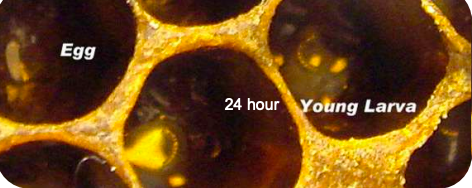
The yellow line in the photo below shows what the trim line might look like. Everything below it is removed.
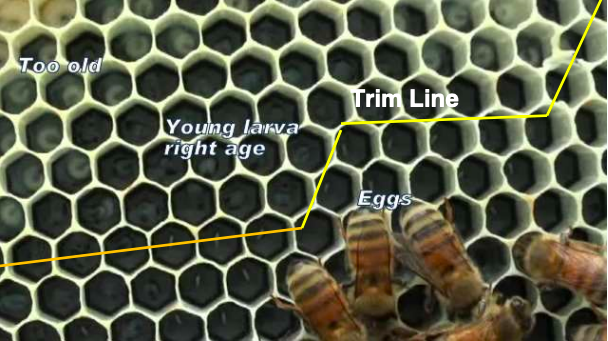
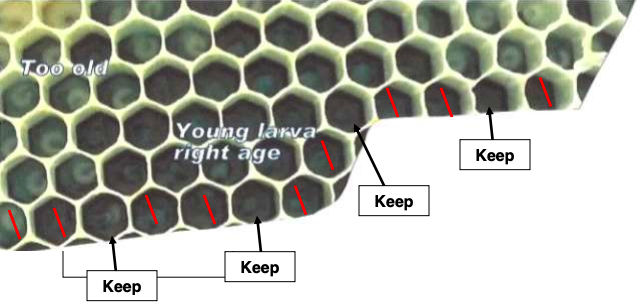
- Destroy two thirds of the future queen cells left along the lower trim margin. This avoids having too many queen cells too close together. Squash two cells, keep the third, squash two and keep the third, etc.
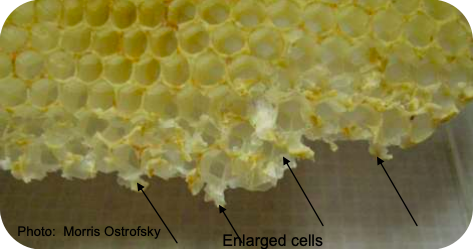
- Enlarge the remaining cells containing the larvae by pushing the lower cell wall downward into a vertical position This simulates a queen cup and encourages the bees to build queen cells there.
- Transfer the prepared Miller frame into the center of the brood area in the now queenless cell builder hive.
Step 7: Feed and reduce entrance.
Before closing up the nuc, add a shim to create some space above the top bars and then add a protein patty. The nuc’s cover should have a 2 to 3 inch circular hole cut into the center. Place an inverted mason jar with 1:1 sugar syrup over the hole. The holes in the Mason jar lid should be 1/16 inch in diameter. Include a feed stimulant, such as Honey Bee Healthy, in the syrup. Cover the feeder with an empty box or bucket to protect the syrup from sunlight.
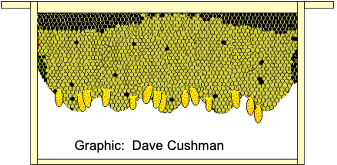
Step 8: Day 18: (Ten days later) Prepare queen cells for mating boxes/nucs.
Remove queen cells from the Miller frame. These cells should look roughly like the shell of a Virginia peanut. Remove some of the surrounding comb along with the queen cell to avoid damage the developing queen. The extra comb also provides a means to attach the cell to another frame.
Step 9: Remove the queen cells and insert them into queenless mating boxes/nucs. (See Nucleus method for more detail.)
- Add enough workers to cover the brood and queen cells.
- Return the original queen to the cell builder hive or leave one or two queen cells to become the replacement queen.
Step 10: Feed and reduce entrance. Before closing up the nuc, add a shim to create some space above the top bars and then add a protein patty. The nuc’s cover should have a 2 to 3 inch circular hole cut into the center. Place an inverted mason jar with 1:1 sugar syrup over the hole. The holes in the Mason jar lid should be 1/16 inch in diameter. Include a feed stimulant, such as Honey Bee Healthy, in the syrup. Cover the feeder with an empty box or bucket to protect the syrup from sunlight.
Step 11: Continue to feed the mating box/nuc for two weeks.
Step: 12: Wait 3 weeks before checking the results. You should find a laying queen with a good brood pattern. If this is the case, transfer the bees into a standard box. If you were not successful, return the frames to the original hive.
Because the Miller method involves several steps and critical dates, a calendar is very useful to organize and coordinate your schedule with the queen rearing schedule. An example of a schedule follows.

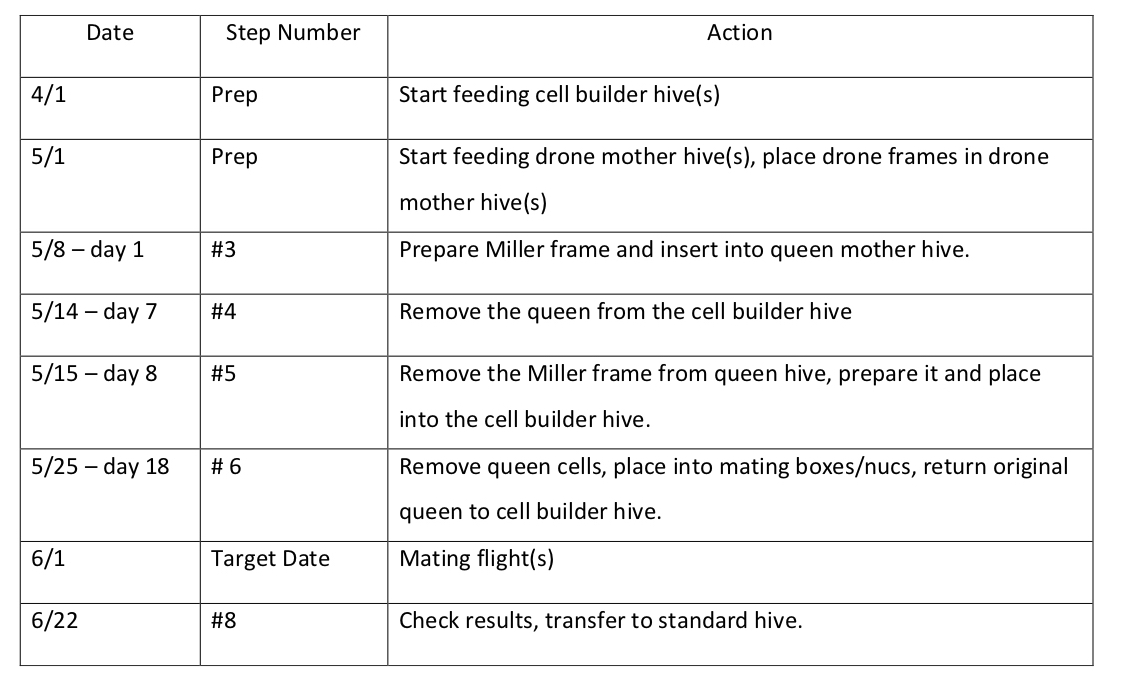
Hopkins Method
Isaac Hopkins described his method of raising queens in 1911. According to G.W. Hayes, “The Hopkins Method of Queen Rearing is as good as and probably better for us than when first introduced 80 plus years ago.” In the same May 1991 edition of The American Bee Journal he noted, “Believe me when I tell you that you can raise more quality queens than you can probably use yourself with virtually no specialized equipment or manipulation.” The usual number of queens raised is about 20 using the Hopkins method.
The Hopkins and Miller methods are similar. The primary difference between them is the orientation of the frame upon which the queen cells are built. With the Hopkins method the frame is horizontal.
Step 1: Decide how many queens/nucs you can produce after evaluating your resources; e.g. amount of brood, workers to care for the brood, queen cells and availability of mating boxes/nucs.
Step 2: Set up the mating boxes/nucs using the original hive as the source of materials. If the resources of the mother (original) hive do not support the number of nucs you choose to make, you can supplement using brood and workers from other hives.
Nucleus configuration:
- Three (3) brood frames of capped brood with some cells that are emerging
- If the queen cells are located singly or in doubles on brood frames, simply include the brood frame with the queen cell(s)
- If the queen cells have been removed from mother hive frames, provide a space in the nucleus frames that are to receive the queen cells by cutting out a small portion of comb. The queen cells can then be placed in the space and fixed in place with a couple of tooth picks.
- one (1) frame of mostly pollen
- one (1) frame of mostly honey
- enough workers to cover the brood and queen cells
Mating box configuration:
- one frame of mostly honey and pollen
- one brood frame with emerging brood
- 2 queen cells
- enough workers to cover the brood and queen cells

Step 3: Day 1: Construct the Hopkins frame and place in queen mother hive.
- Build an unwired frame with foundation held in place with foundation pins. This is the Hopkins frame.
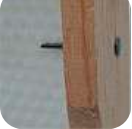
Figure 3.8.14 Foundation pin in Hopkins Frame Unwired frames need be used as this will make later queen cell removal easier.
- Re-arrange the frames to create a space in the center of the queen mother brood box. This is done by removing a little used frame on the outside edge of the brood box. Brush off the bees and place this frame in another hive.
- Place the Hopkins frame in the space created in the queen mother hive.
Step 4: Day 5: Remove queen from the cell builder hive.
- The queen must be removed one day before moving the Hopkins frame from the queen mother hive to the cell builder hive. This queenless condition creates an emergency response and must exist if queen cells are to be raised. The bees respond to this emergency by quickly building queen cells.
- Store the queen temporarily in a small nuc. She will be returned to the cell builder hive at a later stage.
Step 5: Day 6:
- Evaluate the Hopkins frame and look for the presence of 24-36 hour old larvae.
- Look at the Hopkins brood frame from the queen mother hive frame. Since day one the bees will have drawn out the foundation and the queen should have started laying eggs in the new comb.
- You should see drawn comb, eggs and 24-36 hour larvae. If you do not see larvae of this age, replace the frame and wait another day or two
- Look at both sides of the Hopkins frame and select the side containing the most 24 -36 hour old larvae.
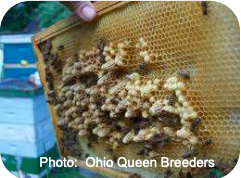
Figure 3.8.15 Hopkins brood frame
- Cull surplus cells in the Hopkins frame.
- Place the selected side face up on a work surface in an area with good lighting, temperature around 80 F, humidity, and NO direct sunlight as this would kill the larvae.
- Reduce the number of potential queen cells from developing too close together (as shown) by destroying two rows of worker cells and leaving the third intact. This provides space to keep the finished queen cells from being damaged when they are removed from the frame.
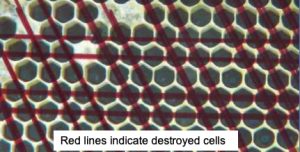
Figure 3.8.16 Destroyed cells - Start at the top of the frame. Use a hive tool and scrape the cells from one side of the comb to the other. Damage the cell clear down to the mid-rib. Within the row of remaining, intact cells, destroy two cells down to the mid-rib and leave every third intact. The red lines on the photo indicate the cells to be destroyed.
- Place a shim above the brood frames in the now queenless cell builder hive. It acts as support for the prepared Hopkins frame and provides space for the protein patty and for the bees to build queen cells.
- Divide the protein patty into quarters and place them in the inside corners of the shim and above the brood frame top bars.
- Place the prepared brood frame on top of the shim and close the hive with a telescoping cover.
- Place an inverted mason jar with 1:1 sugar syrup over the hole. The holes in the Mason jar lid should be 1/16 inch in diameter. Include a feed stimulant, such as Honey Bee Healthy, in the syrup. Cover the feeder with an empty box or bucket to protect the syrup from sunlight.
Step 6: Nine days after placing the Hopkins frame on top of the cell builder (approximately day 15) prepare and transfer the queen cells to queenless mating boxes/ nucs.
-
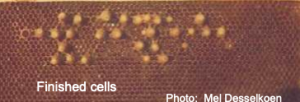
Figure 3.8.17 Finished cells Place the frame in a standing position with the top bar on top and the bottom bar resting on a secure surface. With a sharp, wet knife carefully cut the comb leaving a half inch border around each queen cell.
- Create a cavity the size of the queen cell and border comb in the frame to receive the cell.
- Gently press the border comb with the queen cell into this cavity. Do not press on the fragile queen cell itself. If needed, a tooth pick can be used for additional support. (See Nucleus method)
- Return the original queen to the cell builder hive or place one or two queen cells in the cell builder to become the replacement queen.
Step 7: Feed and reduce entrance. Before closing up the mating box/nuc, add a shim to create some space above the top bars and then add a protein patty. The nuc’s cover should have a 2 to 3 inch circular hole cut into the center. Place an inverted mason jar with 1:1 sugar syrup over the hole. The holes in the Mason jar lid should be 1/16 inch in diameter. Include a feed stimulant, such as Honey Bee Healthy, in the syrup. Cover the feeder with an empty box or bucket to protect the syrup from sunlight.
Step 8: Continue to feed the mating box/nuc for a couple weeks.
Step 9: Wait three weeks to check the results. You should find a laying queen with a good brood pattern. If this is the case, transfer the bees into a standard box. If you were not successful, return the frames to the original hive.
There are a number of ways to raise queens and to do it well. Four methods have been presented. While we beekeepers like to believe we are in control, we can not overlook the queen’s influence. Appropriately we will leave it to her to have the last word.
“…If any old farmer can keep and hive me,
Then any old drone may catch and wive me;
I’m sorry for creators who can not pair
On a gorgeous day in the upper air, I’m sorry for cows who have to boast
Of affairs they’ve had by parcel post,
I’m sorry for man with his plots and guile,
His test tube manner, his test tube smile;
I’ll multiple and I’ll increase as I always have- by mere caprice;
For I am a queen and I am a bee,
I’m devil-may-care and I’m fancy- free,
Love-in-air is the thing for me,
Oh, it’s simply rare In the beautiful air,
And I wish to state
That I will always mate with whatever drone I encounter”
“Song of the Queen Bee”
Poems and Sketches of E.B. White reproduced in Queen Rearing and Bee Breeding Harry H. Laidlaw Jr. and Robert E. Page, Jr.

References:
Harry H. Laidlaw Jr. & Robert E. Page Jr. (First Edition 1997) Queen Rearing and Bee Breeding, Wicwas Press
Larry John Connor (2009) Queen Rearing Essentials, Wicwas Press
Kim Flottum (2011) Better Beekeeping, Quarry Books, pgs 81, 92
Mel Disselkoen (2008) I.M.N. System of Queen Rearing, Self published
G. W. Hayes Jr. (May 1991) The Hopkins Method of Queen Rearing, American Bee Journal
Roy Hendrickson (April 2011) Managing Varroa: Selecting for Resistance & Queen Rearing, American Bee Journal, pg. 349
Media Attributions
- Honey bees © Glenn Apiaries is licensed under a All Rights Reserved license
- Graft-Free-Queen-Rearing-Morris-Ostrofsky © Morris Ostrofsky is licensed under a All Rights Reserved license
- Worker honey bees on comb © Morris Ostrofsky is licensed under a All Rights Reserved license
- Honey bees on comb © Morris Ostrofsky is licensed under a All Rights Reserved license
- Queen cell surrounded by comb border © Morris Ostrofsky is licensed under a All Rights Reserved license
- Nuc © Morris Ostrofsky is licensed under a All Rights Reserved license
- Miller frame © Morris Ostrofsky is licensed under a All Rights Reserved license
- Young larva © Morris Ostrofsky is licensed under a All Rights Reserved license
- Closeup young larva cells © Morris Ostrofsky is licensed under a All Rights Reserved license
- Closeup of young larva cells © Morris Ostrofsky is licensed under a All Rights Reserved license
- Closeup of queen cells © Morris Ostrofsky is licensed under a All Rights Reserved license
- Miller frame © Dave Cushman is licensed under a All Rights Reserved license
- Calendar © Morris Ostrofsky is licensed under a All Rights Reserved license
- Graft-Free Queen-Rearing Morris-Ostrofsky © Morris Ostrofsky is licensed under a All Rights Reserved license
- Another closeup of foundation pin for Hopkins frame © Brushy Mt. Catalog is licensed under a All Rights Reserved license
- Foundation pin for Hopkins frame © Brushy Mt. Catalog is licensed under a All Rights Reserved license
- Hopkins brood frame © Ohio Queen Breeders is licensed under a All Rights Reserved license
- Destroyed cells © Morris Ostrofsky is licensed under a All Rights Reserved license
- Finished cells © Mel Desselkoen is licensed under a All Rights Reserved license
- Honey bees surround a queen bee © Morris Ostrofsky is licensed under a All Rights Reserved license


Feedback/Errata